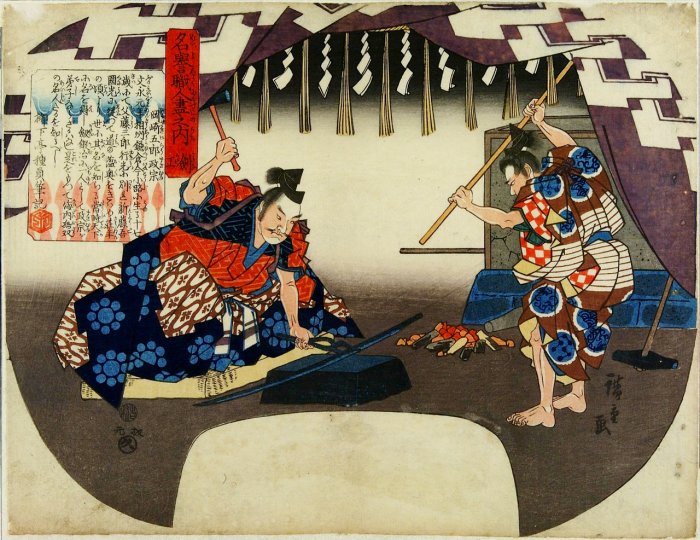Katana ‘Soul Of The Samurai’ – Most Famous Japanese Sword With Long Tradition
A. Sutherland - AncientPages.com - Katana is the most famous Japanese Samurai sword. The Japanese Katana sword is considered "the soul of the Samurai" and one of the deadliest-edged weapons used in ancient and feudal Japan by the Samurai, the members of Japan's knightly class.
Its origin, however, is not entirely known. It represents a combination of both Chinese and Japanese craftsmanship, and in its early form, it may originate from China. It is said that the enigmatic katana sword was born in fire. Since ancient times, the blade has been a symbol of faith and authority. It played an essential role as a base for the concept of the "Japanese spirit."
In his book "Katana: The Samurai Sword" Stephen Turnbull writes:
"To a samurai, one's katana was both a weapon and a symbol. Never has the relationship between man and sword been better expressed than in the words of the great shogun (military dictator) of Japan, Tokugawa Ieyasu (1542–1616), who advised his successors that 'the sword is the soul of the warrior.'
No samurai would ever be without his sword, whether he was wearing armor or everyday clothes, and a sword forged by a celebrated master was one of the most precious gifts a warrior could receive. The sword, in its rest position thrust into the belt, would tell the world that its owner was a true samurai – a member of a social and military elite – since 4 members of the lower classes did not carry weapons (theoretically, at least)…."
Old katana next to the koshirae , shirasaya and tsunagi. Image credit: Samuraiantiqueworld - CC BY-SA 3.0
It also carries the meaning of a protector between the birth and death of a person, protecting them from injury. When the Samurai turned on the sword to pull and chop in one and the same movement, it was undoubtedly awe-inspiring and deadly.
The Japanese word katana only means swords or single weapons, but it is also used as the designation of a particular sword that was used from the 17th century to the late 19th century. The Japanese history of edged weapon craftsmanship stretches back over 2,000 years.
Appearance Of Katana Weapon
In appearance, the katana is a curved, single-edged blade with a circular or squared guard and a long grip to accommodate two hands.
The mythical weapon is made of three kinds of steel with different hardness such as soft (shigane), medium-haired (kawagane), and hard steel (hagane). The process was very complicated and time-consuming and included the treatment of iron ore, which was hammered to a rod, bent in the middle, whipped together, and then bent again (up to sixteen times to get hard steel).
A katana blade - approximately 60-80 cm tall and weighs 1.1-1.3 kg - does not differ much from its immediate predecessor, the tachin, which was usually slightly lighter concerning its length and had a more curved blade that narrowed towards the tip.
What distinguished the katana from the earlier tachin was a change in how the Samurai carried the sword.
Masamune forges a katana with an assistant (ukiyo-e). Image credit: Celestial Sentinel - Public Domain
Previously, the tachin sword was traditionally worn with the cutting edge down. However, during the Muromachi Period (1392–1573), the katana was worn with the cutting edge up by the Samurai.
Advantage Of Katana Over Other Weapons In Critical Situations
Using the katana, a skilled Samurai could draw and slice his opponent with a single motion in the blink of an eye. It was essential in close-combat warfare, where victory depended heavily on short response times.
The maneuver wasn't possible with the tachin, the ancient predecessor of the katana.
Samurai warriors did not exclusively wear the katana sword. However, after 1588, only Samurai wore a katana in combination with another shorter weapon, known as "wakizashi," but this combination was legalized until 1871.
Ancient secrets of the traditional technique of Japanese swordsmithing are today known only to about 300 swordsmiths. The swordsmithing tradition has significantly declined in Japan.
However, at the beginning of the 15th century, there were about 3,550 active swordsmiths, and swords had both outstanding quality and highly artistic appearance. To receive such a sword was a great honor.
Written by – A. Sutherland - AncientPages.com Senior Staff Writer
Updated on September 5, 2022
Copyright © AncientPages.com All rights reserved. This material may not be published, broadcast, rewritten or redistributed in whole or part without the express written permission of AncientPages.com
Expand for referencesMore From Ancient Pages
-
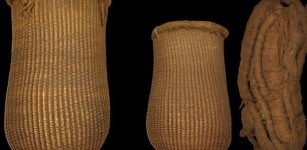 9,500-Year-Old Baskets And 6,200-Year-Old Sandals Found In Spanish Cave
Archaeology | Sep 28, 2023
9,500-Year-Old Baskets And 6,200-Year-Old Sandals Found In Spanish Cave
Archaeology | Sep 28, 2023 -
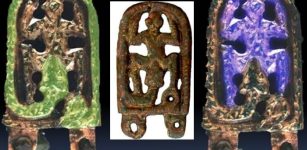 Unique Medieval Bronze Buckle Of A Snake Devouring A Frog-Like Creature Found In Brno, Czech Republic
Archaeology | Dec 13, 2023
Unique Medieval Bronze Buckle Of A Snake Devouring A Frog-Like Creature Found In Brno, Czech Republic
Archaeology | Dec 13, 2023 -
 Strange Community Rules Of Essenes Preserved In The Dead Sea Scrolls
Ancient History Facts | Jun 9, 2020
Strange Community Rules Of Essenes Preserved In The Dead Sea Scrolls
Ancient History Facts | Jun 9, 2020 -
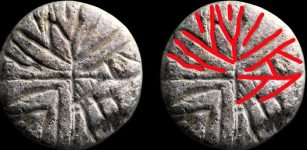 Playing Piece With Runic Inscription Found In Trondheim
Archaeology | Jun 20, 2023
Playing Piece With Runic Inscription Found In Trondheim
Archaeology | Jun 20, 2023 -
 200 Tons Of Silver Hidden From The Romans On The Shores Of The River Lahn
Archaeology | Feb 23, 2023
200 Tons Of Silver Hidden From The Romans On The Shores Of The River Lahn
Archaeology | Feb 23, 2023 -
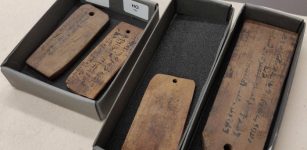 Scientists Reconstruct The Climate Of The Ancient World Using Small Wooden Artifacts And Mummies
Archaeology | Apr 5, 2023
Scientists Reconstruct The Climate Of The Ancient World Using Small Wooden Artifacts And Mummies
Archaeology | Apr 5, 2023 -
 Strange Ancient Accounts Of Fourth Dimensional Phenomena
Featured Stories | Jun 7, 2018
Strange Ancient Accounts Of Fourth Dimensional Phenomena
Featured Stories | Jun 7, 2018 -
 Riddle Of Two Undeciphered Elamite Scripts
Featured Stories | May 19, 2021
Riddle Of Two Undeciphered Elamite Scripts
Featured Stories | May 19, 2021 -
 Unique Historical Discovery – Wreck Of Vasa’s Sister Ship Äpplet Found Off Swedish Coast!
Archaeology | Oct 25, 2022
Unique Historical Discovery – Wreck Of Vasa’s Sister Ship Äpplet Found Off Swedish Coast!
Archaeology | Oct 25, 2022 -
 First Pompeiian Human Genome Sequenced Fron An Individual Who Died After The Eruption Of Mount Vesuvius In 79 C.E
Archaeology | May 26, 2022
First Pompeiian Human Genome Sequenced Fron An Individual Who Died After The Eruption Of Mount Vesuvius In 79 C.E
Archaeology | May 26, 2022 -
 ‘Impossible’ Ancient Knowledge Of The Gods’ Star – First Observations – Part 1
Featured Stories | Aug 29, 2021
‘Impossible’ Ancient Knowledge Of The Gods’ Star – First Observations – Part 1
Featured Stories | Aug 29, 2021 -
 On This Day In History: Moscow Armistice Signed Between Finland And Soviet Union – On Sep 19, 1944
News | Sep 19, 2016
On This Day In History: Moscow Armistice Signed Between Finland And Soviet Union – On Sep 19, 1944
News | Sep 19, 2016 -
 Flower Of Life: Ancient Sacred Geometry Symbol And Blueprint Of The Universe
Ancient Symbols | Oct 8, 2017
Flower Of Life: Ancient Sacred Geometry Symbol And Blueprint Of The Universe
Ancient Symbols | Oct 8, 2017 -
 Viking Law And Order Was Based On The Thing System
Ancient History Facts | Aug 21, 2023
Viking Law And Order Was Based On The Thing System
Ancient History Facts | Aug 21, 2023 -
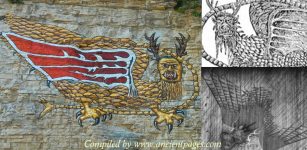 Mysterious Piasa Bird – Native American Dragon That Existed Thousands Of Moons Before The Pale Face Came
Featured Stories | Jan 1, 2018
Mysterious Piasa Bird – Native American Dragon That Existed Thousands Of Moons Before The Pale Face Came
Featured Stories | Jan 1, 2018 -
 Birka: Major Trading Center During The Viking Age
Featured Stories | Feb 12, 2018
Birka: Major Trading Center During The Viking Age
Featured Stories | Feb 12, 2018 -
 Remote North Atlantic Islands Were Settled By An Unknown Group Of Humans Centuries Earlier Than Thought
Archaeology | Dec 27, 2021
Remote North Atlantic Islands Were Settled By An Unknown Group Of Humans Centuries Earlier Than Thought
Archaeology | Dec 27, 2021 -
 Why We Celebrate Saint Lucy’s Day – The Bringer Of Light And Patron Of The Blind
Ancient Traditions And Customs | Dec 13, 2021
Why We Celebrate Saint Lucy’s Day – The Bringer Of Light And Patron Of The Blind
Ancient Traditions And Customs | Dec 13, 2021 -
 2000-Year-Old Tomb Discovered In Northwestern China
Archaeology | Dec 7, 2015
2000-Year-Old Tomb Discovered In Northwestern China
Archaeology | Dec 7, 2015 -
 Surprising Discovery Of 88 Ice Age Human Footprints In Utah Desert
Archaeology | Jul 26, 2022
Surprising Discovery Of 88 Ice Age Human Footprints In Utah Desert
Archaeology | Jul 26, 2022



